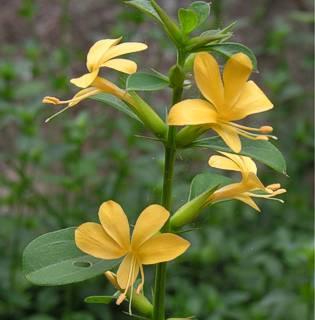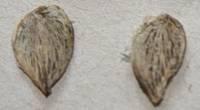Barleria ameliae
Barleria ameliae A.Meeuse
Family: Acanthaceae
Common names: Amelia barleria
Introduction
If you are living in a subtropical area and looking for a fast growing, indigenous plant to solve your problem of planting open sunny areas in your garden, Barleria ameliae is the answer to your problem.

Description
Description
Barleria ameliae is a branched perennial herb or subshrub 0.2-1.2 m high. The leaves are elliptic to lanceolate with the upper half tapering to a sharp pointed apex (tip) and the lower half tapering to a long or short petiole (leaf stalk). Spines are present in the leaf axils (the angle between the stem and the leaf stalk or a branch).
The flowers are pale yellow to orange, arranged in a loose or fairly dense terminal spike with the lower flowers solitary in the axils of the leaves, in late summer to autumn. The corolla (petals of the flower) is 2-lipped. The upper lip is 4-lobed and the lower lip entire. The lower leaves in the inflorescence are more or less like the normal leaves and the upper leaves are usually much smaller. The bracteoles (small leaf-like structures at the base of the flower) taper to an acute apex.

It has a single seed capsule bearing two seeds. When the seed is ripe the fruit capsule explodes to distribute the seeds in different directions.

Conservation Status
Status
Least Concern (LC), this species is not threatened.
Distribution and habitat
Distribution description
Barleria ameliae grows in well-drained sandy soils, in full sun and occurs in Mpumalanga, Eswatini, Mozambique, Zimbabwe, Malawi, Zambia and Namibia, where it grows in woodland, dry open riverine forest, scrub and thicket, on sandy soils.
Derivation of name and historical aspects
History
This species is named after Anna Amelia Mauve (née Obermeyer) 1907–2001, a South African botanist and an authority on Acanthaceae. She was Curator of the Transvaal Museum Herbarium and joined the Botanical Research Institute in 1957, retiring in 1972. The genus Barleria is found in Asia, Africa and America. It contains about 250 species with about 70 species in Africa.
Ecology
Ecology
Barleria ameliae is pollinated by insects and attracts various species of butterflies.
Uses
Use
Barleria species are exceptionally suitable for stabilizing soil erosion, landscaping water-wise gardens, rockeries and sunny areas in the garden.

Growing Barleria ameliae
Grow
Barleria ameliae is propagated either by seed or cuttings:
To prevent seeds being lost, it can be collected as the capsules turn brown. The seeds should be planted in trays in a mixture of two parts good soil and one part clean river sand. Place them in a shady spot in your garden and water once a week. Germination of the seeds takes place after a week. Transplanting the seedlings into bags should be done when the seedlings are more or less 100 mm high.
Cuttings should be made in summer, and you should make use of softwood plant material. Take cuttings of 120 mm length, treat them with a hormone powder and plant them in a mixture of equal parts good soil and river sand. Put the cuttings in a shady place and water twice a week. Transplant the rooted cuttings after about three months into a good soil mixture.
References
- Darbyshire, I., Tripp, E.A. & Chase, F.M. 2019. A taxonomic revision of Acanthaceae tribe Barlerieae in Angola and Namibia. Part 1. Kew Bulletin 74(5): DOI 10.1007/S12225-018-9791-0.
- Fabian, A. & Germishuizen, G. 1982. Transvaal wild flowers. Macmillan, Johannesburg.
- Glen, H.F. 2002. Obituary: Anna Amelia Obermeyer-Mauve (1907-2001). Bothalia 32(1): 127-130.
- Little, J. R. & Jones, C.E. 1980. A dictionary of botany. Van Nostrand Reinhold Compony, New York, Cincinnatti, Toronto, Melbourne.
- Obermeyer, A.A. 1933. A revision of the South African species of Barleria. Annals of the Transvaal Museum 15,2: 162–164.
- Wood, J.R.I., Hillcoat, D. & Brummitt, R.K. 1983. Notes on the types of some names of Arabian Acanthaceae in the Forsskal herbarium. Kew Bulletin 3: 429-456.
Credits
Willem Froneman
Lowveld National Botanical Garden
May 2010, updated March 2024
Plant Attributes:
Plant Type: Perennial, Shrub
SA Distribution: Mpumalanga
Soil type: Sandy, Loam
Flowering season: Late Summer, Autumn
PH: Acid, Neutral
Flower colour: Yellow, Orange
Aspect: Full Sun
Gardening skill: Easy
Special Features:
Horticultural zones









Rate this article
Article well written and informative
Rate this plant
Is this an interesting plant?
Login to add your Comment
Back to topNot registered yet? Click here to register.